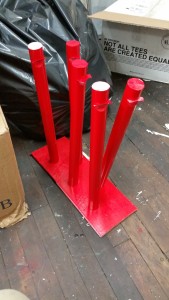For my final project in Physical Computing, I’ve been wavering back and forth over whether to use four slide whistles or four walkmen to play music. I’ve wanted very badly to use slide whistles, but have been nervous about the number of engineering questions that would raise. So I decided this week to construct four (well, five in this case) slide whistles and see what it was like to work with them.
I began by finding an Instructable online (http://www.instructables.com/id/Simple-PVC-Whistle/) and running to Home Depot to gather materials. In my possible p-comp project, I would need to make tones lower than are usual for a slide whistle, so figured that it would be best to use a wider pipe (why, I’m not quite sure… visions of church organs perhaps). I bought 1″ and 1.25″ PVC pipe, and corresponding dowels. Nothing fit snugly, but I figured I could shim what I needed to with masking tape.
Once I was back in my studio, I experimentally cut a notch in the 1″ pipe using a jigsaw, inserted a shimmed and shaved piece of dowel to direct the air, and blew through it.
Nothing. I inserted another dowel into the other end. Nothing. I pulled out the dowel and wrapped it with masking tape, and put it back inside, fairly snug. I blew again. A tone! Success!!
But not a great tone. I cut off the end of the pipe, watched a few more videos online and deduced that the narrower the angle of the blade of the notch (the thing that’s making the sound when you blow across it) the stronger the note I would get. I finally made a notch I liked, and drew a gauge on a piece of masking tape to let me know how big to make the first cut.
Looking at how much pipe I had left, I figured I would make the whistloes 17″ long, which would give me enough material for one extra in case I made a mistake. I would cut my notch, insert the taped dowel, check that the note sounded, and then make the final cut. Working this way, I obtained five more-or-less even whistle bodies.
I then sanded them down (one of my pipes was in really gnarly shape), masked off the sensitive areas and spraypainted them red, using a very impromptu stand I made out of chunks of dowel and a spare piece of plywood.
After a second coat of paint, it was time to unmask and add in the slide, and that’s where things got problematic. The tape-wrapped dowel I had been using to test the whistles had worked okay but not great – I had assumed I would be able to fine-tune a usable slide using tape, or rubber bands, or something. But everything I tried either got stuck or let air through, or (nearly always) both.
(It was around this time that I remembered back to our first class, and to the observation that “straight” and “round” are really just concepts, never exampled in the real world. Feeling a slide travel the different widths of a 17″ length of PVC definitely reinforced that.)
The problem, then, was to find something that could be mounted to the slide that would be both easily movable and, at any given point, essentially airtight. The fellow at the plumbing supply shop by my work suggested cutting a groove in the side of a piece of dowel and mounting an o-ring, which was a brilliant idea, but the hard rubber and narrow profile didn’t allow enough compensation in wider areas of pipe, while it still threatened to get stuck in narrower areas.
In the end, I went to Dick Blick and bought everything squishy I could find. After some experimentation, it turned out that children’s craft foam, hot-glued on top of a whittled plug, gave the closest approximation of what I was looking for. Still not perfect (or near it) but serviceable.
I mounted the slides to pieces of heavy aluminum armature wire and closed off the ends with fender washers.
In the end, these would need a few tweaks before they would really be playable instruments. Dowel and foam isn’t really a good slider (to say nothing of the longevity of such a contraption) – I would want to research further and really find out the right solution. The armature wire is too soft for a slide fixture, the notches aren’t totally uniform… there are definitely ragged edges. But I know more about them than I did before I made one.
And my p-comp project is now officially, finally, not going to involve slide whistles.









